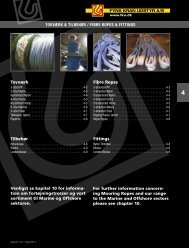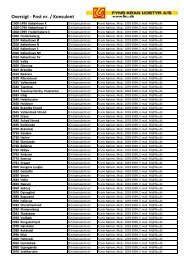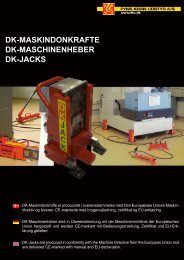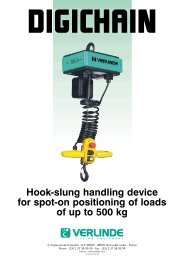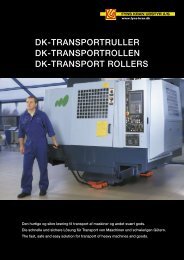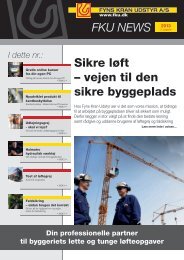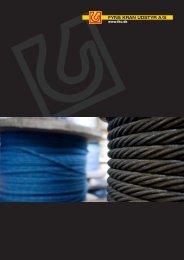Hent pdf-fil - Fyns Kran Udstyr A/S
Hent pdf-fil - Fyns Kran Udstyr A/S
Hent pdf-fil - Fyns Kran Udstyr A/S
Create successful ePaper yourself
Turn your PDF publications into a flip-book with our unique Google optimized e-Paper software.
www.fku.dk<br />
UDDANNELSE & TEKNISK INFORMATION / EDUCATION & TECHNICAL INFORMATION<br />
12-3<br />
Ståltovets grundelementer<br />
Ståltov (Fig. 1):<br />
- Ståltråde der danner en dugt<br />
- Dugter der slås omkring et hjerte<br />
- Hjerte<br />
Disse elementer udføres i forskellig udformning/design<br />
afhængig af, hvilke fysiske krav der stilles til ståltovet,<br />
samt hvad det skal anvendes til. Én dugt kan i visse<br />
tilfælde med fordel anvendes som et ståltov.<br />
En fjerde komponent, der er lige så vigtig som udformningen<br />
og kvaliteten af de tre basiskomponenter,<br />
er indfedtningen af hjerte og dugter (se af snittet<br />
“Vedligeholdelse af ståltovet”)<br />
Fig. 1<br />
The Basic Elements of Steel Wire Ropes<br />
Steel Wire Rope (Fig. 1):<br />
- Steel wires that form a strand<br />
- Strands that are wrapped around a core<br />
- The core<br />
These elements are available in various models/designs,<br />
depending on the physical requirements of the steel wire<br />
rope and its intended application. A single strand can in<br />
certain cases be used quite properly as a steel wire rope.<br />
A fourth component, that is equally as important for the steel<br />
wire rope’s performance as the design and quality of the<br />
three basic components, is the lubrication of the core and<br />
the strands (see “Maintenance of Steel Wire Rope”).<br />
Ståltråd<br />
<strong>Fyns</strong> <strong>Kran</strong> <strong>Udstyr</strong> A/S kan levere ståltov i mange forskellige<br />
kvaliteter – kontakt os, så vi kan imødekomme netop Deres krav.<br />
De stålkvaliteter, som <strong>Fyns</strong> <strong>Kran</strong> <strong>Udstyr</strong> A/S kan levere af standard<br />
ståltove – opfylder som minimum internationale standarder (EN<br />
10264). Herved opnår <strong>Fyns</strong> <strong>Kran</strong> <strong>Udstyr</strong> A/S ståltove en høj grad af<br />
ensartethed.<br />
Minimum brudstyrken på tråden angiver klassifikationen af<br />
ståltovet. <strong>Fyns</strong> <strong>Kran</strong> <strong>Udstyr</strong> A/S` anvender bl.a. følgende trådtyper:<br />
- Ugalv. tråde (primært elevatortove) 1.370 N/mm² (140 kp/mm²)<br />
- Zink-galv. tråde (primært fiskeri) 1.570 N/mm² (160 kp/mm²)<br />
- Zink/alu.-galv. tråde (primært fiskeri)1.570 N/mm² (160 kp/mm²)<br />
- Rustfrie tråde (brudstyrken er dimensionsafhængig) 1.670 N/mm²<br />
(170 kp/mm²)<br />
- Zink-galv. tråde (primært industri) 1.770 N/mm² (180 kp/mm²)<br />
- Zink-galv. tråde (primært industri) 1.970 N/mm² (200 kp/mm²)<br />
Dugter<br />
En dugt er fremstillet (slået) af minimum 3 tråde, der er lagt i én<br />
af mange forskellige designs (geometrisk opbygning). Dugten er<br />
næsten altid opbygget omkring en centertråd. Som regel er trådene<br />
af stål, men de kan også være af fiber (natur- eller kunstfiber) eller<br />
af en kombination af stål og fiber. Antallet, størrelsen og materialet<br />
af de enkelte tråde kendetegner tovet og dets egenskaber. Få og<br />
tykke tråde giver stor slidstyrke, hvorimod mange og tynde tråde<br />
giver stor fleksibilitet (se også afsnittet “Dugttype (dugtdesign)”).<br />
Steel Wire<br />
<strong>Fyns</strong> <strong>Kran</strong> <strong>Udstyr</strong> A/S can supply steel wire ropes in many<br />
different qualities – contact us to find out how we can meet your<br />
requirements.<br />
The qualities of steel that <strong>Fyns</strong> <strong>Kran</strong> <strong>Udstyr</strong> A/S can supply of<br />
standard steel wire ropes – meets international standards (EN<br />
10264). In this way <strong>Fyns</strong> <strong>Kran</strong> <strong>Udstyr</strong> A/S steel wire ropes achieve a<br />
high degree of uniformity.<br />
The minimum tensile strength of the wire defines the classification<br />
of the steel wire rope. <strong>Fyns</strong> <strong>Kran</strong> <strong>Udstyr</strong> A/S offers follwoing wire<br />
types:<br />
- Ungalv. wires (elevator cables) 1,370 N/mm² (140 kp/mm²)<br />
- Zinc galv. wires (mainly fishing) 1,570 N/mm² (160 kp/mm²)<br />
- Zinc/alu.-galv. wires (mainly fishing) 1,570 N/mm² (160 kp/mm²)<br />
- Rustproof wires, tensile strength dependent on size 1,670 N/mm²<br />
(170 kp/mm²)<br />
- Zinc galv. wires (mainly industry) 1,770 N/mm² (180 kp/mm²)<br />
- Zinc galv. wires (mainly industry) 1,970 N/mm² (200 kp/mm²)<br />
Strands<br />
A strand is laid by a minimum of three wires that are arranged in<br />
many different designs (geometric patterns). The strand is nearly<br />
almost arranged around a centre wire. The wires are made from<br />
either steel or fibre (natural or man-made), or a combination of<br />
these.The quantity, size and material from which the individual wires<br />
are made, characterise the rope and its qualities. Fewer, thicker<br />
wires create greater abrasion resistance, whereas a greater number<br />
of thinner wires creates greater flexibility (see also the section<br />
“Types of Strand”).<br />
Version 7.0 - Maj 2013<br />
Odense | Vallensbæk | Esbjerg | Aalborg<br />
+45 7015 2015 | fku@fku.dk<br />
12



